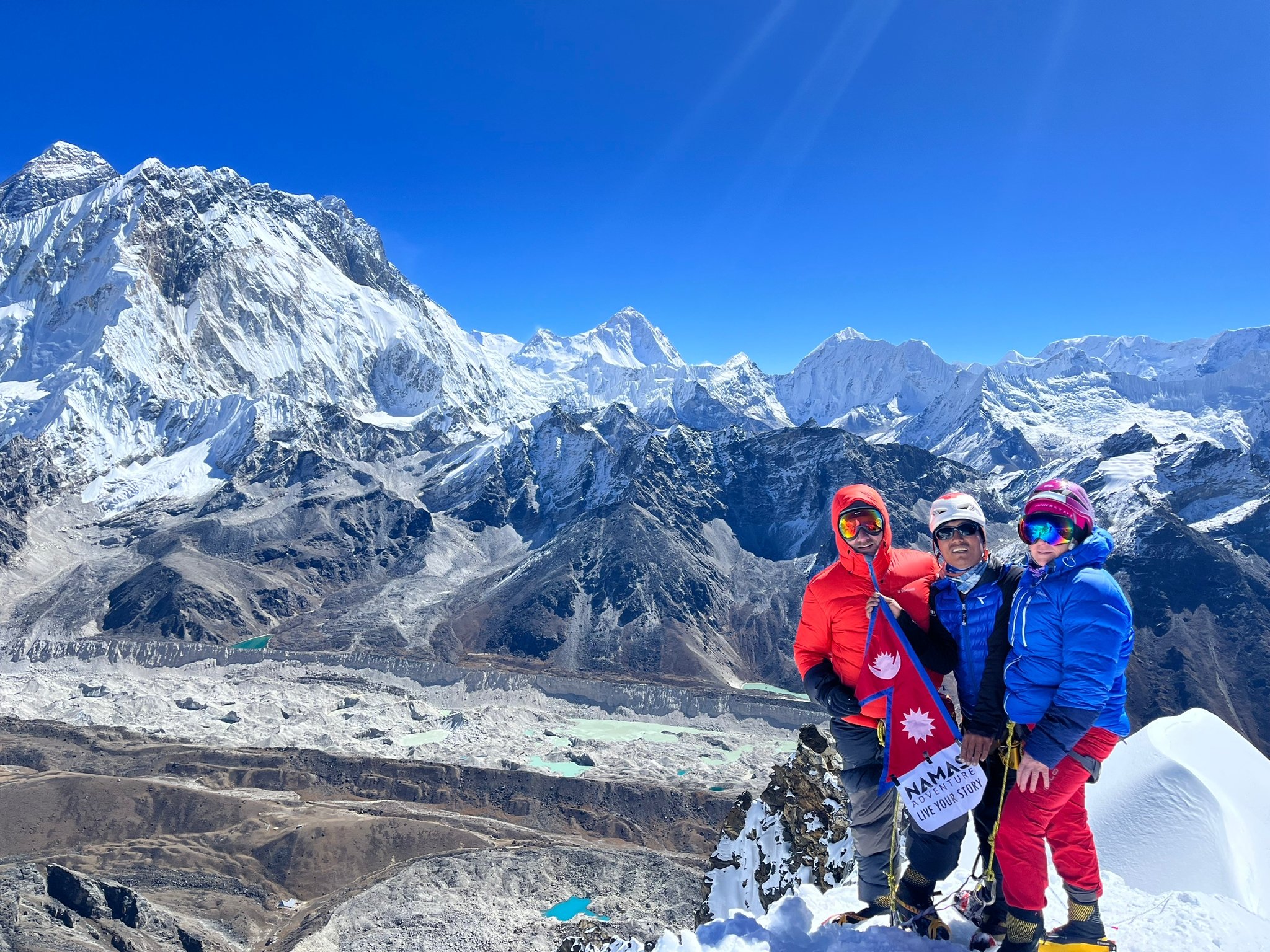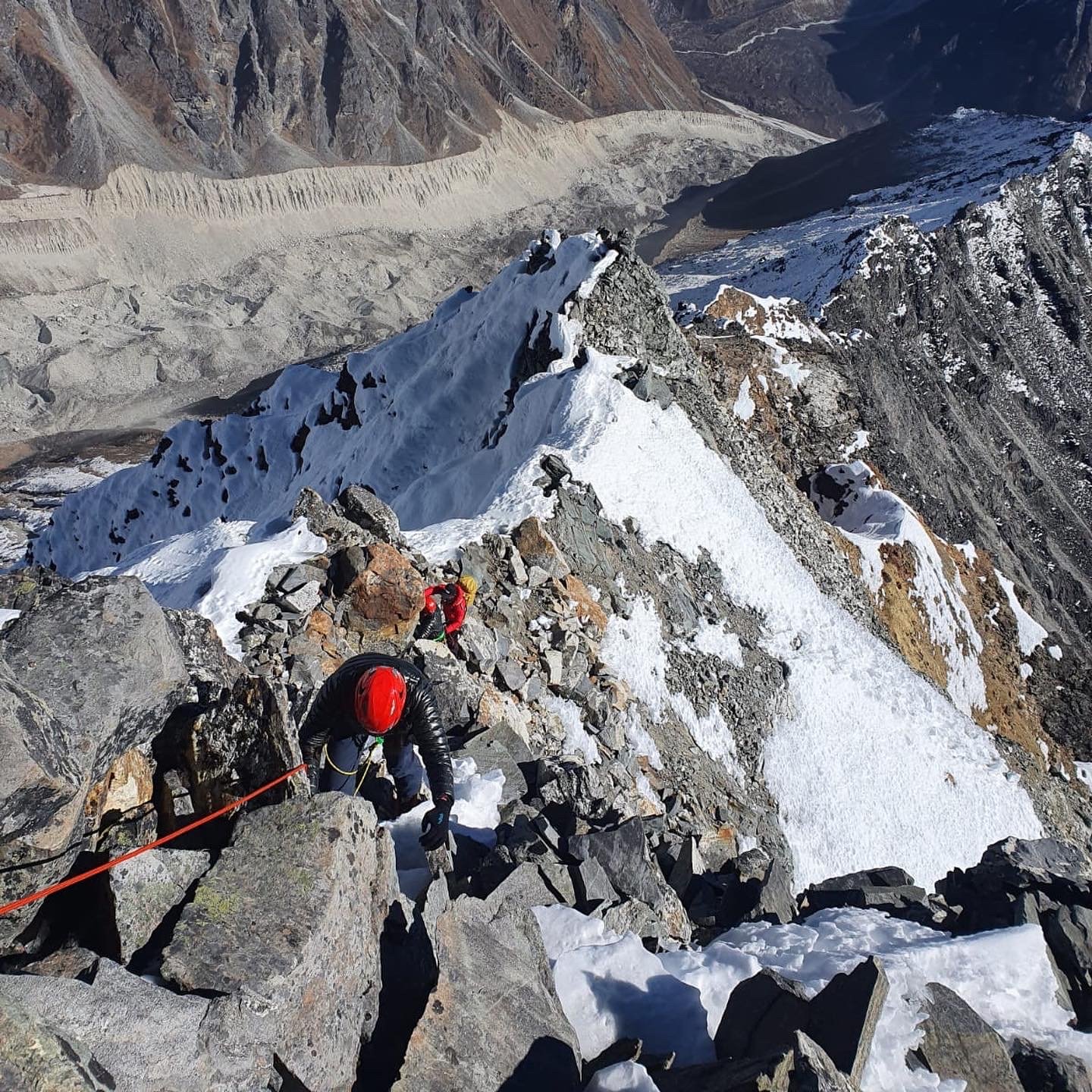Khumbu 3 Peak or Annapurna 5x Summits: Which 6000M Peak Challenge to Climb? – Namas Adventure
When it comes to choosing between the Khumbu 3 Peak Expedition and the Annapurna 5X Summit challenge, it really comes down to what type of adventure you’re craving. Both expeditions offer unique experiences in Nepal’s legendary mountains, but each has its own charm. So, which one will give you the experience you’re looking for? Let’s break it down and help you figure out which one suits you best.
Khumbu 3 Peak Expedition
If you’ve ever dreamed of standing beneath the shadow of Mount Everest, the Khumbu 3 Peak Expedition might just be your dream come true. This trek will take you through the heart of the Everest region, with climbs up Mera Peak, Island Peak, and Lobuche East, offering some of the most iconic views on the planet.
Breathtaking Views of Everest: There’s something magical about looking up and seeing Everest in all its glory. On the Khumbu 3 Peak Expedition, that’s your backdrop. Along the way, you’ll pass stunning vistas of Mount Everest, Lhotse, Makalu, and several other towering peaks. The scenery here is second to none.
Climbing Variety: The climbs themselves will challenge you in different ways. Mera Peak is more straightforward, but Island Peak and Lobuche East will push your skills. Island Peak is particularly technical, with a steel ladder over crevasses and a steep ascent to the summit. It's an exhilarating climb, one that makes you feel like you're truly on an adventure.
Immersive Sherpa Culture: The Khumbu region is rich in Sherpa culture, and throughout your journey, you’ll have the opportunity to learn about the people who call this rugged terrain home. The culture here is as awe-inspiring as the mountains themselves, and this expedition gives you a chance to connect with it on a personal level.
The Khumbu 3 Peak Expedition is perfect for anyone who dreams of Everest and is looking to challenge themselves both physically and mentally, while experiencing the deep-rooted Sherpa culture.
Annapurna 5X Summit challenge
If you’re drawn to quieter trails, breathtaking mountain scenery, and a bit less foot traffic, the Annapurna 5 peak Expedition might be more your style. Set in the stunning Annapurna region, this trek takes you through serene villages and alpine landscapes as you climb Pisang peak 6091M, Chulu East 6584M, Chulu West 6419M, Chulu Far East 6059M, and Thorong Peak 6144M.
Less Crowded, Just as Beautiful: The Annapurna region is just as stunning as the Everest region, but without the same level of traffic. If you’re looking for a more peaceful, less commercialized trekking experience, the Annapurna 3 Peak Expedition offers that. You’ll have more space to breathe and a chance to enjoy the beauty of the Himalayas without the crowds.
Cultural Immersion: As you trek through villages like Manang and explore the Annapurna massif, you’ll get a much deeper sense of local life. The Annapurna region is home to rich traditions, and this trek offers you a chance to connect with the communities in a more relaxed setting.
Challenging, but Rewarding Climbs: The climbs here are a perfect mix of technical and moderate. Chulu West is the most technical of the three, with some tricky climbing near the summit, while Pisang Peak is more moderate but still a solid challenge. The Annapurna peaks offer a different kind of challenge, one that combines a sense of adventure with a touch of serenity.
If you're someone who prefers a more peaceful, cultural experience while still facing a great physical and mental challenge, the Annapurna 5x Summit challenge will feel like home.
So, Which One Should You Choose?
Ultimately, the decision between the Khumbu 3 Peak Expedition and the Annapurna 5 Peak Expedition depends on what kind of experience you're hoping to get out of it.
Choose the Khumbu 3 Peak Expedition if you want the full Everest experience — think iconic views, a variety of climbing challenges, and the chance to immerse yourself in the unique Sherpa culture. If you’ve always dreamed of seeing Everest up close and want to push yourself with some technical climbs, this is the expedition for you.
Choose the Annapurna 5X summit Expedition if you want a quieter, more peaceful trek in a beautiful, less-crowded region. The Annapurna massif is every bit as stunning as Everest, and with its beautiful villages and serene landscapes, you’ll experience the Himalayas in a more intimate setting. Plus, the climbing is no less challenging — you’ll still be tested, but with a slightly different vibe.
Both expeditions are designed for climbers who are physically prepared and ready to take on 6000-meter peaks, and both will challenge you in different ways. Both are full of rewards — stunning landscapes, unforgettable summits, and the sheer joy of being in the heart of the Himalayas.
The Bottom Line: Both Are Life-Changing Experiences
Whichever you choose, both the Khumbu 3 Peak Expedition and the Annapurna 5 peak challenge Expedition will offer you the chance to test your limits, experience some of the most incredible landscapes on Earth, and leave you with memories that last a lifetime. They’re both excellent introductions to Himalayan climbing and will help you develop skills and confidence for bigger climbs in the future. At the end of the day, it’s all about what kind of experience you’re looking for. Whether it’s the towering peaks and cultural richness of Khumbu or the quieter, intimate beauty of Annapurna, you’ll find adventure, challenge, and inspiration in either one.
If you’re ready for the challenge, we would love to have you join us on this unforgettable adventure. For more information, feel free to contact us at bookings@namasadventure.com.
Climb higher. Embrace the challenge. And become the adventurer you were always meant to be.
Live Your Story!
A beginner and intermediate's guide to climbing 6000 meter peaks in Nepal during spring season - Namas Adventure
Lobuche East
Climbing the giants of the Nepalese Himalayas is a dream for many adventurous souls. With elevations reaching up to 8,000 meters, these peaks are not only challenging but also require proper planning and preparation. However, climbing peaks of around 6,000 meters can also be a rewarding experience for beginners and intermediates alike, especially during the spring season in Nepal.
March to May and Mid October - Mid December, is considered the best time to climb these peaks as the weather is great, and the snow is firm enough for climbing. The period also offers clear views and friendly trekkers along the trails.
In this guide, we will look at some of the best beginner and intermediate 6000-meter peaks to climb in Nepal during the spring season.
beginners/novice
Mera Peak (6,476 meters)
Mera Peak is the highest trekking peak in Nepal, located in the Makalu region. The peak is a perfect choice for beginner-level climbers who want to experience the thrill of climbing in a remote area. The climb is challenging, with steep sections of ice and snow, but the summit provides a breathtaking view of the surrounding peaks, including Mount Everest, Lhotse, and Makalu.
Lobuche East (6,119 meters)
Lobuche East 6119M is a popular peak located in the Khumbu region. It is considered a moderate climb with a relatively straightforward route. The peak offers a breathtaking view of the surrounding peaks, including Mount Everest, Lhotse, and Nuptse. The peak can be reached via the Gokyo and Everest Base Camp trek
Island Peak (6,189 meters)
Also known as Imja Tse, Island peak is a popular climbing peak. It is considered one of the easiest 6000-meter peaks to climb, with a moderate level of technical difficulty. The peak is located in the Khumbu region and can be reached via the famous Everest Base Camp trek.
The climb is relatively straightforward, and the summit provides a panoramic view of the surrounding peaks such as Lhotse Sharr and Ama Dablam.
Chulu Far East (6,019 meters)
Chulu Far East peak is a high-altitude trekking peak in the Annapurna circuit region. A non-technical and straightforward climb, making it accessible to those without previous technical climbing experience. However, the steep terrain and scree slopes encountered during the approach can make the climb more challenging. It is very similar to Mera Peak expedition.
The Chulu Far East Peak climb itinerary offers climbers the opportunity to witness the stunning natural beauty of the Annapurna region. The summit provides panoramic views of Annapurna II, III & IV, Gangapurna, Manaslu 8163M, Pisang Peak, Chulu West Peak, and Dhaulagiri, as well as the plains of Tibet to the north. You can also further extend your trip to visit the emerald Tilicho lake 4900M and cross the Thorong-la-pass to enter into the forbidden Kingdom of Upper Mustang.
Yala Peak (5732 meters)
Yala Peak, standing at 5732 meters, is a part of the Langtang Lirun Himal range and is situated in close proximity to the Tibetan border. The peak offers a non-technical climb, making it an ideal terrain for novice climbers to gain experience and explore the world of mountaineering.
The base camp for the expedition is located at an altitude of 4500 meters and offers spectacular views of nearby peaks such as Langtang Lirung, Lenpo Gang, Dorje Lakpa, and the majestic Sishapangma on the Tibetan side.
intermediate
Chulu West Peak (6,419 meters)
Chulu West peak is an exhilarating 6000-meter-plus climbing peak in the mid-western part of Nepal. This peak is less frequently visited and attracts fewer climbers. Climbers embark on their peak climbing adventure by setting out to Chulu base camp from Ledar village, passing through one of the world's most beautiful trekking routes. The peak sits against the stunning backdrop of the Annapurna massif range, with the Himlung Himal to the northeast and the majestic Manaslu peak in the distance.
In conclusion, climbing 6000-meter peaks in Nepal during the spring season is a fantastic way to experience the thrill of climbing in the Himalayas. The peaks we listed above offer a challenging yet manageable climb for beginners and intermediates alike, with breathtaking views of the surrounding landscapes and mountain peaks. It is important to take note that climbing any peak in the Himalayas should not be taken lightly and having a knowledgeable guide and proper gear is crucial. Always make sure to acclimatize properly, have fun, pay attention to the guide’s instructions, and have an amazing experience of climbing in the Himalayas.
Are you interested in visiting Nepal during the spring season and climbing your first 6000-meter peak in the Himalayas? Our experienced team who have been making summit dreams true for the last 15 years is here to help make that dream a reality. Who knows, after your first climb, you may be inspired to tackle even more challenging peaks like Everest. Let's make it happen together!
“Do or Do not, there is no try” - YODA
Namas Adventure Team















